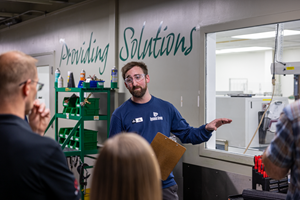Automotive Outlook: Steady Improvement in 2013
Wood on Plastics
One of the true bright spots in the economy over the past 24 months has been the automotive industry. Our forecast for 2013 calls for another solid increase of 6% to 8%.
As we close out 2012 and look forward to 2013, the prevailing trend in the U.S. economy is pretty much the same as it has been for the past two years. We remain mired in a slow-growth recovery in which real GDP is expanding at a subpar pace of about 2% per year and the labor market is creating about 150,000 jobs per month. This is the macroeconomic equivalent of treading water.
But one of the true bright spots in the economy over the past 24 months has been the automotive industry. In 2011, the number of motor vehicles assembled in the U.S. expanded by 12% over the previous year, and in 2012 that rate of growth has accelerated to over 20%. Our forecast for 2013 calls for another solid increase of 6% to 8%, which will bring the industry back very close to pre-recession numbers of vehicles assembled.
For plastics processors and other suppliers to the auto industry, a trend even more important than rising market demand for new autos is that of rising profitability for automakers. As the chart above illustrates, profits in the auto sector have been hard to come by in recent years. But this situation may have turned around in 2012. After all of the trials and tribulations of bankruptcy and government bailout, it now appears that the U.S. auto industry is once again making both cars and money. This should allow auto makers to pay their suppliers and continue to invest in products and ideas that will enhance their productivity and competitiveness.
Our forecast for 2013 is based on the continuation of several beneficial trends that have emerged recently. The most important is that overall GDP growth in the U.S. is expected to ramp up to 2.5-3% in 2013. This increase will be attributable in large part to increased activity in residential construction. This sector was badly damaged when the housing bubble burst in 2008, and it has languished at very low levels for most of the past five years. But recent improvements in housing starts and home prices indicate that a sustainable upward trend is gaining momentum.
These escalations in home prices and construction activity are important to the auto industry for several reasons. First, rising home prices make consumers more comfortable about purchasing big-ticket items. The second reason is that rising home prices will allow banks to lend money more easily. As home prices rise, more people will be able to use their homes as collateral for loans. So when it is a good time to buy a new house, it is also a good time to buy just about anything else.
The expected increase in construction activity will result in a lot of new jobs being created, and a strengthening labor market is always good for the new car 大象传媒. It will also spur demand for vehicles such as pickup trucks and delivery vans because these are the preferred vehicles for construction workers.
There are also several positive trends not directly related to construction activity that will persist through the coming year. The average age of cars in America is over 10 years. Many households have postponed purchasing a vehicle due to uncertain economic conditions, but these fears will ease as 2013 progresses. Another trend is the inexorable upward march of fuel prices. This will generate steady demand for smaller, more fuel-efficient vehicles.
WHAT THIS MEANS TO YOU
•Natural gas will continue to gain popularity as a fuel for motor vehicles. As a result, processors will find opportunities in both new auto parts and also the expansion of the infrastructure needed to deliver natural gas at a retail level.
•The price of steel and most other metals will continue to rise. This will push demand for car parts made of plastics because they are less expensive to make as well as lighter in weight.
•Cars that drive themselves will likely be a major product of the future. This will not happen in the next two years, but it will be a dominant feature in 10 years.
About the Author
Bill Wood, an economist specializing in he plastics industry, heads up Mountaintop Economics & Research, Inc. in Greenfield, Mass. Contact BillWood@PlasticsEconomics.com.
Related Content
For Extrusion and Injection-Blow Molders, Numerous Upgrades in Machines and Services
Uniloy is revising its machinery lines across the board and strengthening after-sales services in tooling maintenance, spare parts and tech service.
Read MoreImpacts of Auto’s Switch to Sustainability
Of all the trends you can see at NPE2024, this one is BIG. Not only is the auto industry transitioning to electrification but there are concerted efforts to modify the materials used, especially polymers, for interior applications.
Read MoreMedical Tubing: Use Simulation to Troubleshoot, Optimize Processing & Dies
Extrusion simulations can be useful in anticipating issues and running “what-if” scenarios to size extruders and design dies for extrusion projects. It should be used at early stages of any project to avoid trial and error and remaking tooling.
Read MoreMedical Molder, Moldmaker Embraces Continuous Improvement
True to the adjective in its name, Dynamic Group has been characterized by constant change, activity and progress over its nearly five decades as a medical molder and moldmaker.
Read MoreRead Next
Beyond Prototypes: 8 Ways the Plastics Industry Is Using 3D Printing
Plastics processors are finding applications for 3D printing around the plant and across the supply chain. Here are 8 examples to look for at NPE2024.
Read MoreSee Recyclers Close the Loop on Trade Show Production Scrap at NPE2024
A collaboration between show organizer PLASTICS, recycler CPR and size reduction experts WEIMA and Conair recovered and recycled all production scrap at NPE2024.
Read More







